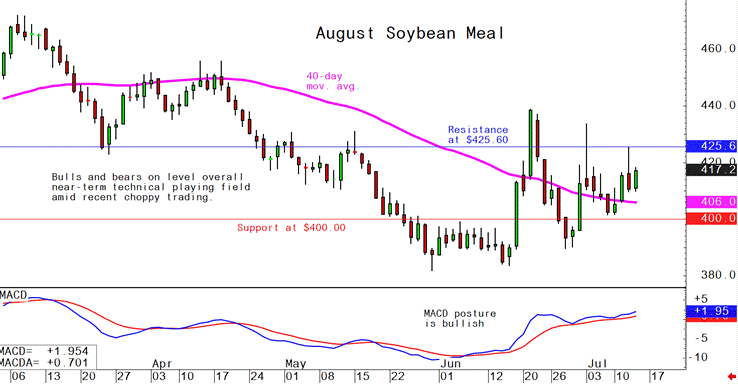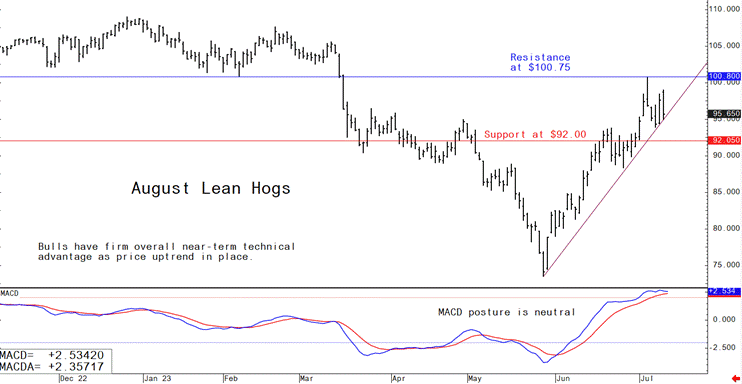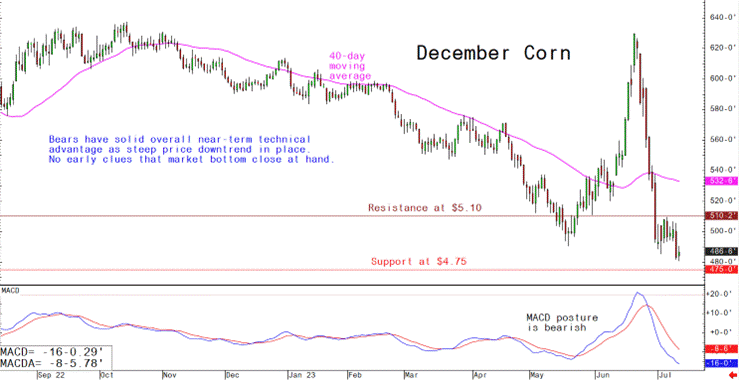



Pig outlook: Lean hog futures bulls keep price uptrend alive
Analyst Jim Wyckoff shares US and global swine market newsAugust lean hog futures last week hit a nearly four-month high and the bulls are still enjoying a price uptrend in place on the daily bar chart. Continued fundamental strength in the cash hog market should support more gains in futures. The CME confirmed Monday’s cash index quote of $98.66, which was up 51 cents from Friday. Tuesday’s preliminary quote came in an additional 70 cents higher to $99.36. The hog market cash rally could last well into summer as slaughter levels will likely be the lowest of the year and continued grocer demand will place a solid floor under pork prices.
Chinese meat imports rise
China imported 670,000 MT of meat in June, up 12.1% from May and 11.1% more than last year. China doesn’t break down the preliminary meat trade data by category, but the increase was driven by pork imports, which have been on the rise since late 2022. During the first half of 2023, China imported 3.81 MMT of meat, up 10.2% from the same period last year.
USDA Livestock and Poultry: World Markets and Trade
World Trade Outlook Relatively Unchanged While Brazil Makes Gains
The outlook for global meat trade remains relatively unchanged from the prior (April) forecast.
Beef and chicken meat exports are not significantly revised while pork is raised 2 percent from the last forecast. However, Brazil continues to make export gains and set new records for beef, pork, and chicken meat.
Brazil beef exports are revised 1 percent higher to 3.1 million tons on greater production and firm China demand. Brazil cattle prices have declined significantly compared to main competitors – Uruguay and Argentina – and lower beef prices support shipments to Southeast Asia, South America, and Middle East markets.
Brazil chicken meat exports are revised 2 percent higher to 4.8 million tons on firm shipments to Asia, the Middle East, and smaller developing markets. As of July 12, Brazil remains free of highly pathogenic avian influenza (HPAI) in commercial operations and does not face restrictions as key competitors do.
Brazil pork exports are revised 8 percent higher to 1.5 million tons on strong exports to most Asia markets, including particularly robust shipments to China and Hong Kong. Declining feed prices in Brazil are anticipated to further incentivize production and bolster price competitiveness.
Global pork production for 2023 is virtually unchanged from the April forecast at 114.8 million tons. Increases in the production forecast for China, Canada, and Brazil offset declines in EU, Japan, the Philippines, and Mexico. Despite mostly negative margins industry-wide, China production is higher on greater than previously expected slaughter as producers seek to reduce herds and maintain cash flow. EU production continues to wane due to pressure from environmental regulation, weaker consumption, and relatively elevated feed costs. Philippines pork production is lowered 3 percent due to the expansion of African swine fever in key production regions.
Global pork exports for 2023 are forecast 2 percent higher from the April forecast to 10.8 million tons as stronger shipments from the United States and Brazil more than offset declines from Canada, UK, and EU. Reduced EU pork supplies provide opportunities for the United States and Brazil to gain market share in several Asia markets including South Korea and the Philippines. Strong demand from China has benefited most major pork exporters year to date.
China’s sow herd contracts further in June
China’s sow herd declined 1.68% in June compared with the prior month, state-backed Shanghai Securities News reported. The pace of the decline is bigger than in prior months, suggesting that farmers are accelerating culling of sows to cut their losses.
Weekly US pork export sales
Pork: Net US sales of 24,500 MT for 2023 were down 6 percent from the previous week and 9 percent from the prior 4-week average. Increases primarily for China (13,700 MT, including decreases of 100 MT), Japan (3,800 MT, including decreases of 200 MT), Mexico (3,600 MT, including decreases of 100 MT), South Korea (1,300 MT, including decreases of 600 MT), and Canada (600 MT, including decreases of 500 MT), were offset by reductions for Australia (400 MT). Exports of 19,300 MT were down 46 percent from the previous week and 41 percent from the prior 4-week average. The destinations were primarily to Mexico (6,800 MT), Japan (2,600 MT), China (2,600 MT), Canada (1,600 MT), and South Korea (1,600 MT).
The next week’s likely high-low price trading ranges:
August lean hog futures--$92.50 to $100.75 and with a sideways-higher bias
August soybean meal futures--$400.00 to $425.60, and with a sideways bias
December corn futures--$4.70 to $5.10 and a sideways bias
Latest analytical daily charts lean hog, soybean meal and corn futures










